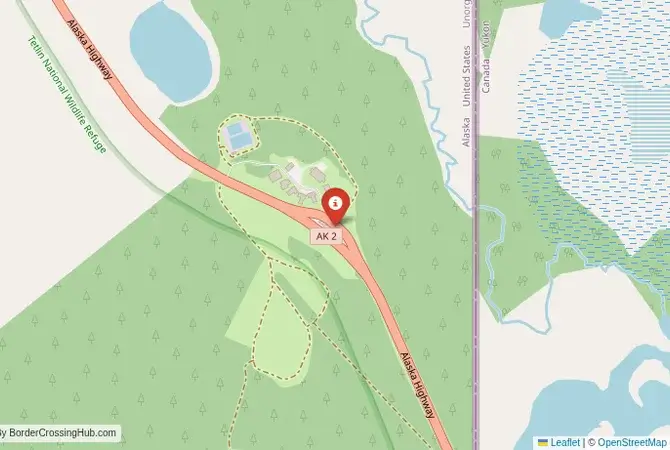
Approximate Border Location
Border Countries
- 🇺🇸United States
- 🇨🇦Canada
Border Cities
- 🇺🇸Beaver Creek, Alaska
- 🇨🇦Beaver Creek, Yukon (Alcan Highway)
Wait Times
15-30 min for pedestrians/vehicles
Operating Hours
Open 8:00 AM – 8:00 PM
Crossing Types
Pedestrians, vehicles
Border Type
Land crossing via road
Peak Times
Mornings (7-10 AM), summer
Daily Crossings
~500 travelers/vehicles
Currency Exchange
Limited near Beaver Creek (USD, CAD)
Safety Information
Remote, weather hazards
Languages Spoken
English
Accessibility Features
Ramps
About Beaver Creek, Alaska & Beaver Creek, Yukon (Alcan Highway)
General Overview
Nestled on the historic Alaska Highway, the Beaver Creek, AK – Beaver Creek, YT border connects Alaska’s Southeast Fairbanks with Yukon’s westernmost community. This 24/7 crossing, a lifeline for travelers and truckers, offers a rugged entry to Alaska’s untamed wilderness or Yukon’s vast tundra, surrounded by dense forests and sweeping mountains.
Historical and Geopolitical Context
Built in 1942 as part of the Alaska Highway to support World War II logistics, this crossing replaced earlier trails used by Athabascan communities. Formalized in 1972 with the Alcan Land Port of Entry, it handles CA$1 billion in annual trade, primarily timber, fuel, and mining equipment. The region’s indigenous heritage fosters cross-border ties, with cultural exchanges like powwows strengthening community bonds. In 2022, COVID-19 restrictions sparked protests, and 2025 saw tightened Canadian smuggling checks, causing delays for trucks. Yukon’s 24-hour transit rule for U.S.-bound travelers—requiring passage from Watson Lake to Beaver Creek within a day—demands careful planning. Check news for disruptions, as protests or inspections can snarl operations.
Before Crossing
Crossing borders gets messy sometimes, think political flare-ups or gates shutting fast. Good travel insurance is a must for handling doctor visits, trip disruptions, or security scares. Don’t get caught unprepared. To find a policy that’s got your back, check out reliable plans today for peace of mind.
Crossing Procedures and Wait Times
Open 24/7, the border sees moderate traffic, with waits of 10-30 minutes, peaking in summer (June-August) due to RV and tourist traffic. U.S. immigration at Alcan, near milepost 1221, processes exit stamps; Canadian immigration in Beaver Creek, 18 miles north, handles entry. Most nationalities (e.g., Europeans, Australians) get a 90-day visa-free stamp for Canada; U.S. entry requires a passport or NEXUS card. Carry your passport, vehicle registration, and insurance. NEXUS lanes are unavailable, reflecting the crossing’s remote nature. English is widely spoken, though basic French may help in Yukon. Wait times are posted on U.S. Customs’ website or via 907-774-2252; Canadian updates are at 867-862-7230. Ensure compliance with Yukon’s transit rule to avoid penalties.
Scam Awareness
Scams are uncommon but include money changers in Beaver Creek offering poor rates; use ATMs or banks in Whitehorse, 280 km east. Taxi drivers may overcharge (~$30-40 USD) for short trips; negotiate fares upfront. Unofficial “border helpers” may offer paperwork assistance—avoid them, as the process is straightforward. Duty-free shops are absent, but local vendors may sell “tax-free” crafts or fuel; verify legitimacy with established businesses. In 2024, Reddit users reported fake guides targeting RV campers, offering overpriced tours—book through Whitehorse operators like Yukon Tourism. Always check vendor credentials to avoid inflated prices or scams.
Transportation Options
No public buses cross directly; taxis (~$30 USD) or private cars take 10-15 minutes between Alcan and Beaver Creek via the Alaska Highway’s two-lane stretch. From Beaver Creek, Yukon Transit buses to Whitehorse (4 hours, ~CAD 50) run infrequently—check schedules at local lodges. In Alcan, buses to Fairbanks (6 hours, ~$60 USD) are limited; confirm with Alaska Direct Bus Line. Roads are paved but remote, winding through tundra with mountain vistas. Pedestrians can cross, but towns are 5-10 km apart, making vehicles essential. Winter ice and snowdrifts demand caution; check Alaska’s 511 or Yukon’s 867-667-3943 for conditions. The route’s vast wilderness, with occasional moose or caribou sightings, adds a thrilling allure.
Nearby Attractions and Tips
Beaver Creek’s Rendezvous Days festival in July celebrates Yukon culture with music and crafts, while Kluane National Park, 100 km east, offers glacier hikes and grizzly bear sightings—book tours through Whitehorse operators for reliability. In Alcan, the Tetlin National Wildlife Refuge, 50 km south, is a haven for birdwatching, with bald eagles and trumpeter swans. Carry USD or CAD, as ATMs are scarce, and small shops like Beaver Creek’s general stores prefer cash. Stay in Beaver Creek for basic lodges like the 1202 Motor Inn or campgrounds like Westmark RV Park. A Canadian SIM card ensures connectivity, as U.S. signals fade north. Try local diners for hearty stews, bannock, or wild berry pies. Summer markets in Whitehorse, a 4-hour drive, offer indigenous crafts and fresh produce.
Seasonal and Weather Considerations
Summer (June-August) brings mild weather (15-25°C) and moderate tourism, with waits up to 30 minutes during RV season. Winter (December-March) delivers heavy snow (-20 to -5°C) and icy roads, requiring winter tires and chains; check 511 services for updates. Spring and fall are quiet but snowy, with muddy conditions possible. Peak holidays, like Canada Day or U.S. Independence Day, increase traffic slightly, so cross early. Yukon’s midnight sun in summer and northern lights in winter add unique charm to the journey.
Planning Your Crossing
Bring a passport or NEXUS card, vehicle documents, and cash for small transactions. Follow Yukon’s 24-hour transit rule for U.S.-bound travel, use official transport, and check wait times online or by phone. Avoid unofficial vendors to steer clear of scams. This crossing connects Alaska’s raw wilderness with Yukon’s vast tundra, offering a blend of adventure, history, and remote tranquility for intrepid travelers.
No reviews yet.
